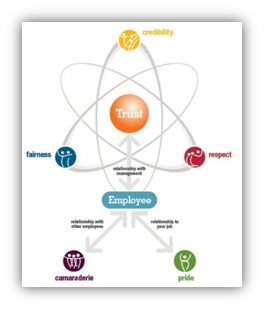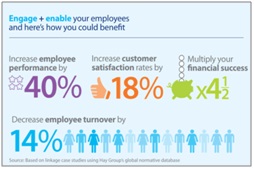
Research Paper By Grace Kong
(Leadership and Executive Coach, CANADA)
 [Note: Softchoice LP company was used in this paper as an example, based on my personal experience as the Senior Human Resource Manager with the firm.]
[Note: Softchoice LP company was used in this paper as an example, based on my personal experience as the Senior Human Resource Manager with the firm.]
In today’s corporate culture it is a challenge when companies look at how they can differentiate themselves from others. It’s trying to understand what sets one company out from another. And in these days where competition is at its peak, there are many very successful organizations that have done it well and have won by reaping the rewards of being successful, not only by increased financial profits but through a great corporate culture and their ability to attract and retain strong talent.
So how do these companies do it? How do they win and become a company great? What does a strong corporate culture offer, which others may not? Could establishing a coaching culture play a part in making companies successful? There are many influences that can make a company successful; only choosing the right elements will contribute to making a company great.
What make a company great?
There are a number of factors that can make a company great and become successful. A couple of key elements include developing corporate goals set by the organization to market gaining share to company reputation. However, the one thing that stands strong behind many successful organizations is the ability to have a strong workforce and its ability to attract and retain strong talent. It is known that people are the ones that make companies successful and without the right people, companies cannot strive and thrive.
Great companies focus on building upon different elements. Based on findings from Glassdoor, an American website where employees and former employees anonymously review companies and their management[1], successful organizations succeed through a four elements. Elements found in successful companies which people wish to work for include: i) organizations that have a strong positive culture, firmly grounded in a meaningful purpose, ii) an environment that offers real chances for individuals to grow professionally, iii) a workplace that offers people the opportunity to work with people they respect & like, and iv) a work environment that offer work individuals the opportunity to develop and be challenged.[2]
By having these key elements in place, it may not be the only answer to attracting the right people? And incorporating these elements, does it evolve a company into an “Employer of Choice”? Perhaps it may. For a company to get branded as an “employer of choice”, at a minimum they must have a strong Employee Value Proposition offering, which includes elements noted earlier, but it also includes such things as the company’s strength (ie. company brand & product), career opportunities, culture (ie. values & mission) and its rewards & recognition offering (ie. total rewards, result-oriented recognition, flexible work environment). Having these elements, however, doesn’t just automatically make a company attractive. Beyond the EVP offerings, the most critical element to build is a strong positive corporate culture that reinforces the benefits of these offerings.
Building a Strong Corporate Culture
 Building a strong corporate culture means building a “Great place to Work”. According to the Great Places to Work organization, great workplaces are built based on the daily relationships that an employee experiences within the workplace. Key factors that build upon this relationship include “Trust”, “Pride” and “Enjoy”.[3]
Building a strong corporate culture means building a “Great place to Work”. According to the Great Places to Work organization, great workplaces are built based on the daily relationships that an employee experiences within the workplace. Key factors that build upon this relationship include “Trust”, “Pride” and “Enjoy”.[3]
| TRUST the people they work for;Have PRIDE in what they do; andENJOY the people they work with.[1] |
How can a company build “Trust” the defining principle of great workplaces? Well trust it is created through ensuring there is management’s credibility, inclusive of respect with which employees feel they are treated, and the extent to which employees believes they should be treated fairly. In order for companies to ensure that these elements of trust are fostered, they need to ensure that they have a culture that reinforces these behaviours.
Corporate Culture Built on Trust
Building or transforming a culture without trust strong level of trust between manages and their employees may result in an overall failure. As the saying goes, “…employees leave managers not companies…”, hence, without a level of trust, it is hard to build strong relationships when it comes to transforming a culture. As noted by Deepak Chopra, references in his article Three Proven Qualities of Great Leaders: #1 Trust[5], leaders are people which individuals wish to follow, it is the simple idea where by individuals look for a leader that is there for them and is thinking of them in their best interest. And if their best interest is at stake then, a strong level of trust needs to be in place for the relationship to be strong.
So how does a company transform a culture that’s built on trust found between the relationship of managers and their employees? Could coaching be the answer to building this positive environment? Could a culture of coaching build & sustain an organizational strength through these dimensions? Perhaps it can, if certain fundamentals are considered. Fundamentals which includes the organizations ability to understand the power & value of coaching and how it can potentially contribute positively to the overall organizational performance, additionally, for coaching to work, it is critical and important to ensure leaders have the ability and knowhow to coach employees in a manner that will change behaviors and competencies. Lastly, for a culture of coaching to work, the organization must be open to an environment that offer employees the support of coaching them to be empowered and trusted to make decisions and to take on greater accountabilities.
Could companies “win” with a Coaching Culture?
Could companies actually benefit by establishing a coaching culture? Perhaps if done right. Establishing a coaching culture begins at the top with the most senior leaders and their strong beliefs that this is the right cultural transition for the organization. With senior leadership support, it then subsequently impacts the company structure as a whole from top to bottom. The goal is to build a foundation whereby coaching, is the established new way of working rather than just a trendy term that will be tossed aside after a period of time. Integrating coaching into the workplace requires the company to recognize the importance of how coaching can evolve an entire workforce towards higher performance, by developing the strength of each manager, through coaching techniques that will help drive performance and facilitate change behaviors of the employees over time. That is, if managers can effectively coach their employees well; there is a direct correlation to increasing the performance of the employees as they develop skills that will help them strive to reach their fullest potential.[6]
A coaching culture can subsequently impact the entire organizational structure through engaging the workforce across the organization to coach. By engaging the workforce, a company can achieve higher company performance and potential with coaching guidance employees become more focused, have higher level of accountability, greater positive energy & attitudes and become more engaged. Then a greater commitment to success is emanated by employees to succeed. With such engaged employees, the company can reach its strategic and financial goals with a greatly increased success rate.
At Softchoice LP, a leading North American provider of technology solutions and services, the organization took the steps to create a Coaching Culture. The focus was to develop the leaders to become proficient at coaching employees to achieve greater success in their overall performance, resulting in increased success for the organization. Although the transformation to a coaching culture took some time, the appropriate steps were taken to move to this new culture.
Leaders as Coaches
It is recognized that organizations that effectively prepare managers to coach through training and support are 130% more likely to realize stronger business results and 39% stronger employee results through higher levels of engagement, increased productivity and providing higher levels of customer service. Additionally, organizations whose leaders that coach “very frequently” resulted in a 21% higher business results, all according to a study by Bersin & Associates.[7]
If there is focus on building the coaching capabilities of leaders, it is important to help leaders understand that there is a strong correlation between coaching and increased level of performance and improved delivery of results. Coaching well and successfully, may also result in the following improvements:
Building a coaching culture effectively, may result in overall higher performance and increased talent development of employees which subsequently may also lead to increased corporate performance. However, there needs to be focus on how leaders are supported through this process. To build a culture where coaching is the foundation of how an organization achieves its successes, a company must first build in key steps that align to a work environment that fosters a foundation of a coaching within its culture targeted with the best intention that this change in culture will result in the organization move towards the goal of achieving overall positive business results. Steps include:
- Building Leadership Coaching Capabilities
- Alignment to Corporate Strategy
- Optimizing Employee Performance through Coaching
-
Building Leadership Coaching Capabilities
It is not enough to just have senior leader support in advocating coaching as the key tool to driving this cultural transformation; managers also need to understand how to coach. Developing leaders as coaches’ requires helping leaders to first understand what coaching is, how to distinguish it from other management skills and why it is important, then providing them with tools & techniques on how to coach and do it well. With these specific elements in place, it is then guiding these leaders on how they can recognize opportunities for coaching opportunities to coach & develop employees accordingly to guide them to achieve success.
At Softchoice, the company made the strategic decision to partner with a specialized firm Box of Crayons[8] that delivered a program called “Coaching for Great Work ®” which focused the training for leaders on the concept of coaching and how managers & leaders could coach more effectively. At first, when managers were asked whether or not they had ever coached before, 90% of the managers in the program acknowledge they did, and felt they did it well. When asked to provide examples of the coaching they provided to their employees, the examples were other forms of leadership styles, but no true examples of coaching were demonstrated. They included examples such as:
Giving the leaders the opportunity to share these examples, emphasized that the leaders really didn’t have a good understanding of what coaching was. It was then the opportunity for Softchoice to target the development for the managers in a particular manner to help them truly learn the value of coaching.
The targeted development on coaching included simplistic approaches to coaching fundamentals which focused on a solid understanding of how to:
In the first year of launching the Coaching for Great Work training at Softchoice, 88% of all leaders took the training and started to use their learnings. And based on a survey that was conducted by the organization with employees, where they were asked, if they had received coaching from their managers, overall 74% of the overall employee population confirmed they did. This was overwhelmingly positive as it was a sure sign that the company was starting to move in a direction of a Coaching Culture.
-
Alignment to Corporate Strategy
If coaching is done well, in theory, it can be a powerful way to shift behavior, increase engagement, enhance thinking and subsequently it can make a difference to the way people do business and the way businesses can succeed. Aligning employees’ achievements, learnings and personal growth & goals to the organization’s strategic plan, will provide employees with the opportunity to share in the overall corporate journey in working towards the greater corporate goal.
In order for corporate goals to be met by the greater population within an organization, coaching skills need to be well embedded within an organization to help get great results. In a Harvard Business Review study written by Daniel Goleman’s Leadership That Gets Results, research discovered that a manager’s leadership style was responsible for on average 30% of the company’s bottom-line profitability. Goleman also noted, “Although the coaching style may not scream “bottom-line results,” it delivers them.”[9]
As such, for a company to establish a coaching culture and for this type of culture thrive and grow; it is important that each and every manager within the company is required to have a solid understanding of what the corporate priorities and strategies are, as well, they would need to be equipped with the coaching skills needed to engage their teams to help them align their goals and objectives to the work they do, to ensure it is focused on achieving the results and strategies set by the organization. This may sound simple enough, but the transition from theory to practice is proving tricky.
-
Optimizing Employee Performance through Coaching
As noted, aligning employee performance through coaching to corporate strategy to achieve overall corporate performance may not be as simple as it seems. In many cases, leaders inherently try to bring out the best in their employees through encouragement, providing feedback and by guiding them to embrace the goals they are trying to achieve. To optimize and increase overall performance through each individual, managers should be trained to use coaching techniques as noted above, to effectively manage individual performance to optimize productivity. This can be done by specifically tailoring coaching including the following:
Leaders within organizations that strategically use their coaching skills to tailor their discussions with their employees can start to see a difference in their employees overall performance. An increase in performance, that results in a higher commitment to performance goals, both personally and professionally, as such it then enhances overall corporate performance. As a result, there is an increased passion and drive throughout the organization, which then results in an overall increased energy throughout the organization.
At Softchoice building in developmental discussions with employees, whilst using coaching techniques, resulted in the business achieved significant shifts in people desire to increase their performance as they felt they were contributing to the bottom-line performance. The increased effort taken by managers in aligning employees’ performance and development to overall corporate strategies had also increased a greater level of value during one-on-one discussions. It also began to increase the level of trust between managers and the employees through the focused coaching discussions. This then contributed to the overall employees’ engagement scores which rose by 10% from 73% to 83% year over year.
Coaching Culture Challenges
Providing training to leaders on coaching, aligning goals to corporate strategies and optimizing employee performance doesn’t automatically transition a culture to Coaching Culture. It takes time and in some cases there are challenges that crop up. These include challenges of having to adapt to coaching styles associated with different generations within the workforce. It could also include managing through barriers such as employees who do not gravitate to working in an environment of coaching, as some employees may not be ready for coaching and vice versa; some leaders don’t fully grasp the concept of coaching due to lack of experience, understanding of the concept believe in the believe in the benefits of coaching or just lacks experience using it. Any of these elements can delay or stall an organization from moving towards a Coaching Culture.
So how do we avoid these challenges? Changing a culture in itself is a huge challenge in itself. Transforming a culture can take years and years to get it to where the company wishes it to be. And in some cases, companies may never even transform due to a number of reasons. However, those that are successful in transforming their culture it can take on average three to five years.[10]
It goes back to recognizing the importance that was raised at the beginning. Transformational change in an organization culture begins with the senior leaders in the organization. Normally the first year is spent getting senior leaders to model and engage in the behaviors that the company is aspiring to. In a coaching culture, they are the leaders that are not only standing behind the value of a Culture of Coaching; they are demonstrating the behavior by coaching their direct reports and others throughout the organization. The second year is spent teaching and training the remaining leaders about the engagement of change. And in a culture of coaching, it is importance to ensure leaders have the know-how to leverage coaching skills well to foster drivers of engagement. The third year is focused on time spent with the remaining employees to align to this transformation; that is getting the individual contributors to envision this new culture, and establish how to personally leverage from the coaching opportunities they would have with their managers and peers on this change.
To simplify the concept, taking the following step can help with the transition:
- Understand the Culture: Be aware of what a Coaching Culture is. Identify how it aligns to the overall corporate values and the company’s mission.
- Alignment at the Senior Leadership Team: Ensure the senior leaders within the organization believe in the transforming culture. That they are able to model the behaviors found within the new culture.
- Model the Behaviors of the New Culture: Leaders are the role models to the success of a cultural change. Change takes place based on the behaviors, values, beliefs and actions and of the leaders’ reaction to the transformation. If the leaders do not model or align to the new culture, the transformation will fail.
- Share the Vision with Everyone: Culture will not change unless the vision of the new culture is shared with everyone within the company. Get everyone involved and be able to support those that are slow at adapting to the change.
Does a Coaching Culture Really Benefit an Organization?
So bringing back the reference of what makes companies great, utilizing coaching techniques to establish a coaching culture offers a positive environment where all employees can maximize their potential and performance, whilst leveraging their own coaching skills to help one another excel and build on the overall success of the organization. Additionally, in trying to keep employees engaged, establishing a coaching culture will help keep employees focused on achieving overall excellence not only for themselves with guidance through a coaching environment offered by their managers and possibly their peers, performance would then lead to contributions to achieving the overall company success.
In the element of “trust”, as noted earlier, a coaching culture also builds upon strengthening a level of trust within a work environment. A coaching culture offers employees a safe trusting environment for feedback and encourages an environment of open communication among employees. This type of open communication lends to enhance and foster an increased level of trust with both management and across the team environment. In a strong & established coaching culture environment, coaching conversations soon become the norm in adjusting conversations to address behaviors, attitudes and directing development & performance to optimize overall business results.
Winning with a Coaching Culture
 In summary, a coaching culture can truly benefit an organizations success, as seen through the findings! As noted above, if done right, with senior leadership support, with an understanding that coaching takes time and commitment at all levels of the organization and if managers are trained with a strong coaching foundation, it would result in a win with happier more engaged and enabled employees. This would then result in a greater win, with overall increased employee performance, which would then leads to elevated levels of customer satisfaction, increased corporate financial success and an overall decreases level of employee turnover.[1]
In summary, a coaching culture can truly benefit an organizations success, as seen through the findings! As noted above, if done right, with senior leadership support, with an understanding that coaching takes time and commitment at all levels of the organization and if managers are trained with a strong coaching foundation, it would result in a win with happier more engaged and enabled employees. This would then result in a greater win, with overall increased employee performance, which would then leads to elevated levels of customer satisfaction, increased corporate financial success and an overall decreases level of employee turnover.[1]
Organizations that embark on a transformation of creating a culture of coaching, over time, can reap the rewards and benefits, as it impacts engagement, productivity, revenue, and other key business strategies. And in the years to come, organizations that effectively take on such a journey and embraces a coaching culture will have the opportunity to celebrate more wins for years to come!
Resources
[1] Glassdoor:
[2] http://www.forbes.com/sites/erikaandersen/2013/12/13/2104-best-companies-to-work-for-4-things-that-make-them-great/
[3] http://www.greatplacetowork.ca/our-approach/what-is-a-great-workplace
[4] http://www.greatplacetowork.ca/our-approach/what-is-a-great-workplace
[5] Deepak Chopra’s Article: https://www.linkedin.com/pulse/three-proven-qualities-great-leaders-1-trust-chopra-md-official-
[6] American Management Association Study; COACHING: A Global Study of Successful Practices.
[7] High-Impact Performance Management: Maximizing Performance Coaching, Bersin & Associates
[8] http://www.boxofcrayons.biz/coaching-skills-for-managers/coaching-for-great-work/
[9] Harvard Business Review, Daniel Goleman: Leadership That Gets Results https://hbr.org/2000/03/leadership-that-gets-results
[10] Ivey Business Journal; Organizational Change:
[11] http://atrium.haygroup.com/images/uploaded/MarketingPS/PS/Effectiveness-Benefits-graphic.gif
